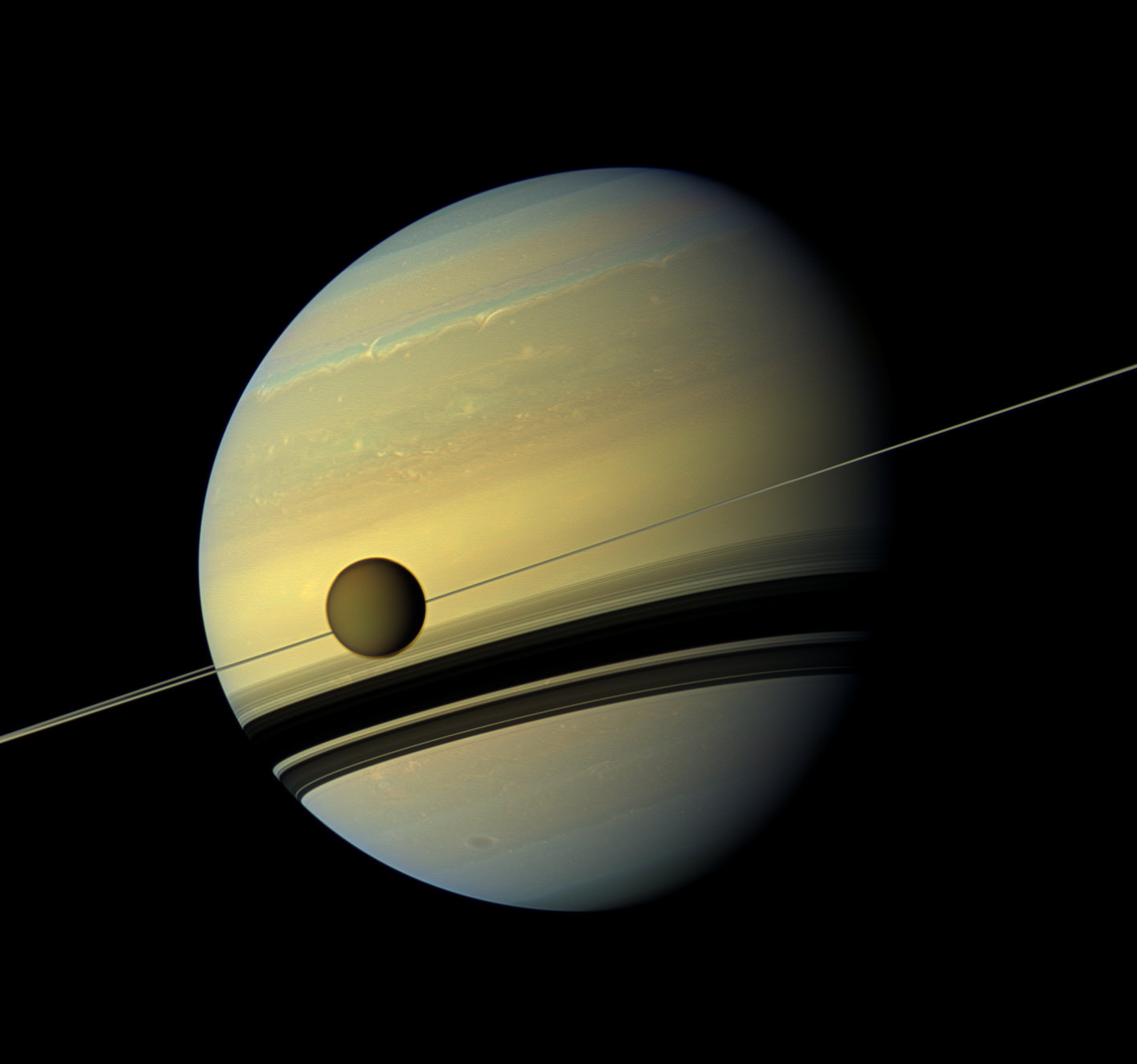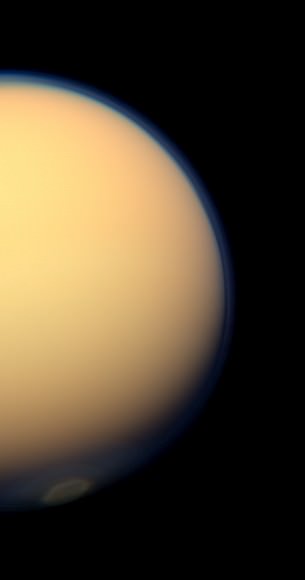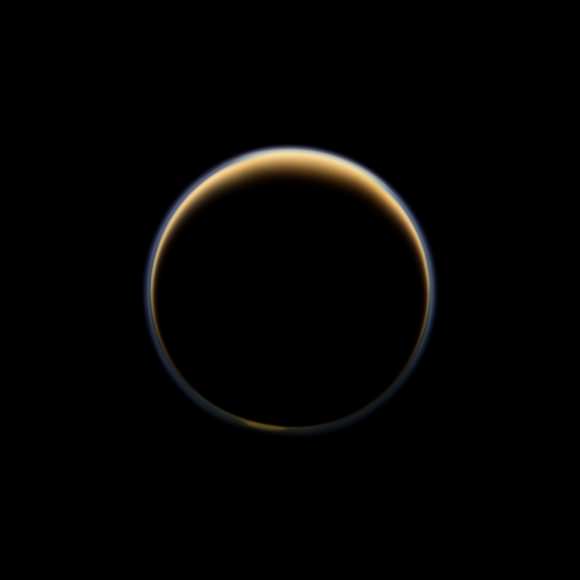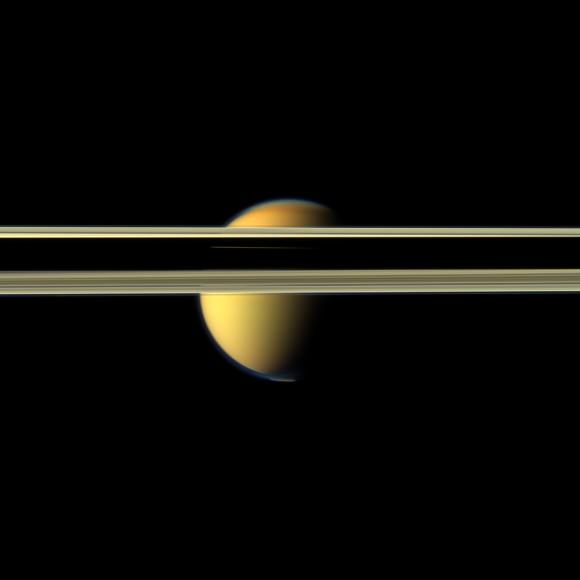The giant moon Titan passes in front of Saturn in this natural-color, wide-angle view from NASA’s Cassini spacecraft. Image Credit: NASA/JPL-Caltech/SSI
[SPOILER ALERT: Viewing these images will force you to change your computer wallpaper]
Here on Earth, it’s almost time for the burst of fall color that signals the change of seasons in the Northern Hemisphere. Saturn’s color too is transforming subtly as the gas giant slips into a Saturnian spring and autumn as seen in this series of true-color images from NASA’s Cassini spacecraft.
Titan, a moon larger than the planet Mercury, hangs before the rings and changing colors of Saturn in the first of four spectacular images release by NASA and the Cassini Imaging Central Laboratory for Operations (CICLOPS).
“For no other reason than that they are gorgeous, the Cassini imaging team is releasing today a set of fabulous images of Saturn and Titan…in living color…for your day-dreaming enjoyment,” said Carolyn Porco, Cassini imaging team lead based at the Space Science Institute in Boulder, Colordo, in an email blast.
When Cassini arrived at Saturn eight years ago, the planet’s northern hemisphere, locked in winter, showed azure blue. Now as winter passes to the southern hemisphere, the colors are reversing as the blue fades from the north and rises in the south.
“Note that our presence at Saturn for the last eight years has made possible the sighting of subtle changes with time, and one such change is obvious here,” Porco said. “As the seasons have advanced, and spring has come to the north and autumn to the south throughout the Saturn system, the azure blue in the northern winter Saturnian hemisphere that greeted Cassini upon its arrival in 2004 is now fading; and it is now the southern hemisphere, in its approach to winter, that is taking on a bluish hue.”
Scientists believe that the increasing blue color in the south likely is due to the increasing intensity of ultraviolet light from the Sun which produces the haze. Methane in the atmosphere also absorbs light toward the red end of the spectrum while reflecting blue light. This view looks from just above the ring plane with the Sun shining from above casting broad shadows on the colorful clouds of Saturn. The image was taken on May 6, 2012 from about 778,000 kilometers (483,000 miles) from Titan.
Some of the views, including this image of a vortex at Titan’s south pole are only possible because of a newly tilted, or inclined, orbit that takes Cassini high over the poles of Saturn and its moons. Scientists first noticed the detached mass of clouds over the south pole in March. The swirling mass of the vortex stands out clearly against the golden cloud deck surrounding Titan.
The recently formed south polar vortex stands out against Titan in this natural-color view from NASA’s Cassini spacecraft. Image Credit: NASA/JPL-Caltech/SSI
Sunlight scattering through Titan’s atmosphere forms a ring of color as NASA’s Cassini spacecraft cruises along the night side of Saturn’s largest moon. Image Credit: NASA/JPL-Caltech/SSI
A glowing hint of the polar vortex shows in this image looking toward the night-time, Saturn-facing side of Titan. Sunlight scattering through Titan’s atmosphere forms the ring of color in this image taken about 216,000 kilometers (134,000 miles) from Titan.
Saturn’s rings cut colorful Titan in half in this image from NASA’s Cassini spacecraft. Image Credit: NASA/JPL-Caltech/SSI
The rings obscure Titan in the final image of the quartet. The image is taken from just above the northern, sunlit side of the ring plane. Saturn’s shadow cast along the rings create the dark swath in the center of the image but if you look close, you can see a tiny sliver of Titan through the Cassini Division, the largest gap in Saturn’s wide rings.
“Cassini has been in orbit now for the last eight years, and despite the fact that we can’t know exactly what the next five years will show us, we can be certain that whatever it is will be wondrous,” said Porco.
About the author: John Williams is owner of TerraZoom, a Colorado-based web development shop specializing in web mapping and online image zooms. He also writes the award-winning blog, StarryCritters, an interactive site devoted to looking at images from NASA’s Great Observatories and other sources in a different way. A former contributing editor for Final Frontier, his work has appeared in the Planetary Society Blog, Air & Space Smithsonian, Astronomy, Earth, MX Developer’s Journal, The Kansas City Star and many other newspapers and magazines.





Superb pictures fromage cassini! Really amazing!
Tagged as: Cassini, NASA, polar vortex, rings, Saturn, Titan
Read more: http://www.universetoday.com/97128/changing-hues-signal-transition-of-seasons-at-saturn/#ixzz255GI0tq7
Saturn and Titan in natural colour is really beautiful.
ah, good ol’ cassini. never disappoints.
Maybe I missed it at some point, but how are these pictures set up to be taken? Does Cassini randomly take photos, are they lined up/calculated ahead of time by earth programmers, a combination of both, perhaps? I know that the Hubble photos are planned in advance using the coordinates of the objects, but how are these shots of the dynamic interplay of Saturn with its rings and moons focused and exposed? I don’t believe Cassini is just “snapping away” and these photos are the few “good” results from a stream of exposures…